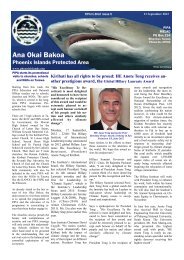Nomination for a World Heritage Site 2009 - Phoenix Islands ...
Nomination for a World Heritage Site 2009 - Phoenix Islands ...
Nomination for a World Heritage Site 2009 - Phoenix Islands ...
You also want an ePaper? Increase the reach of your titles
YUMPU automatically turns print PDFs into web optimized ePapers that Google loves.
al 2004). Research suggests that these high rates are not just an artifact due to limited<br />
sampling, <strong>for</strong> adjacent seamounts in New Caledonian waters have been found to share an<br />
average of just 21% of their species, and seamounts on separate ridges approximately 1000<br />
km apart in the Tasman and Coral Seas have only 4% of their species in common (Richer de<br />
Forges et al. 2000. See also UNEP/CBD/COP/7/INF/25).<br />
The biological characteristics of most deep-sea species associated with seamount ecosystems<br />
render them particularly sensitive to human disturbance and exploitation. The slow growth,<br />
longevity, late sexual maturity, and restricted distribution of many of these species (<strong>for</strong><br />
example, deep-sea corals, sponges and fish) make them particularly vulnerable to human<br />
impacts and the risk of extinction. Concerns over the impact of fishing and the potential loss<br />
of this biodiversity are amplified by the limited in<strong>for</strong>mation about the taxonomy, biology and<br />
ecology of most of the species found in deep ocean areas. Destructive fishing activities in<br />
these areas could bring about extinctions of entire groups of organisms that are still<br />
undiscovered (UNEP/CBD/COP/7/INF/25).<br />
(From: www.cbd.int/doc/meetings/pa/pawg-01/in<strong>for</strong>mation/pawg-01-inf-01-en.pdf)<br />
In regards to the relevance of seamounts to pelagic ecology and fisheries, the summit depth<br />
below the surface appears to be as important as the elevation above the sea floor. From this<br />
point of view, seamounts can be classified into 3 classes (Anon., 2006)<br />
(From: www.wcpfc.int/sc2/pdf/SC2_EB_IP5.pdf):<br />
1) Shallow: summit reaching the euphotic zone<br />
2) Intermediate: summit not reaching the euphotic zone but above the lower limit of<br />
the Deep Scattering Layer (DSL), and<br />
3) Deep: summit below the DSL.<br />
Seamounts in Class 1 and 2 may be characterised by specific oceanographic features linked to<br />
a more dynamic environment that will have a potential impact on the pelagic ecosystem and<br />
fisheries exploiting it. Feeding is probably the main reason why large pelagics gather around<br />
seamounts.<br />
From in<strong>for</strong>mation collected from exploratory cruises, benthic fauna on seamounts appears to<br />
be characterised by a very high percentage of organisms previously unknown to science. The<br />
high number of undescribed species makes it difficult to compare the biodiversity of different<br />
seamounts or of continental slope and seamounts. Seamounts are different from continental<br />
slopes and can be compared to islands as far as faunal biogeography is concerned; this has<br />
been demonstrated with corals. Like oceanic islands, seamounts appear to be characterised by<br />
a high level of endemism and closely adjacent seamounts can exhibit very distinctly different<br />
benthic fauna with high degrees of local endemism.<br />
The 2000 deep-sea surveys by New England Aquarium recorded the first distribution records<br />
of sixgill (Hexanchus griseus) and Pacific sleeper (Somniosus pacificus) sharks <strong>for</strong> this part<br />
of the Pacific from 900 meters depth near Kanton. It is probable that the seamounts of PIPA<br />
have great importance <strong>for</strong> pelagic and commercially important fishery such as tuna and<br />
skipjack. With 25% of the world’s seamounts already degraded the pristine seamounts of<br />
PIPA provide critical protection <strong>for</strong> these fragile ecosystems and associated species,<br />
representing a conservation resource of global significance.<br />
49





